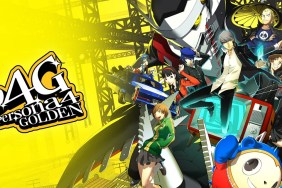After 20 hours of gameplay, I don’t much care who the culprit is.
When you start Persona Q: Shadow of the Labyrinth, you’ll have to choose between the protagonist of either Persona 3 or Persona 4 and then lead the characters you’ve come to know and love from each game through mazes. Ultimately, you'll find that this Nintendo 3DS game, the first Persona game on the platform, asks a lot from your protagonist, Yosuke, Yukari, and even Koromaru, the lovable pup from Persona 3. It’ll take time, patience, and loads of energy to find the end of even one dungeon here, so read on before rushing out to buy your copy.
On one hand, Persona Q offers more of the characters, writing, art style, music, and even combat that you’ve come to know and love. On the other hand, it obscures much of what makes the franchise so endearing. For some, this means that Persona Q proves less of a Persona game, relying on map-scrawling and incredibly deep combat systems to stave off boredom in a world devoid of social links, a calendar, and even the means to eat a beef bowl every once in a while. But I still adore it as an engaging and largely satisfying portable game.
Persona Q doesn’t leave a lot of room for newcomers. In fact, that’s my chief complaint about the title, particularly as it stands alone on a new platform and loses much of the accessibility present in the two games it draws entertaining and hugely likable character drama from. Seeing Mitsuru’s no-nonsense approach to Shadow combat largely clashing with Teddie’s off-the-wall personality leads to the kind of laughable dialog you would expect. That goes an incredibly long way towards loving gameplay that borders on a slog.
Click here to read Review Log 04: I'm Solving a Mystery, If That's Quite Alright With You>>
There’s the factor that all Japanese-made role-playing games seem to stumble on, that subtle quality where the game's theme can feel nebulous at first, and then there’s a hugely satisfying Persona-specific quality permeating throughout Persona Q. The game drips and oozes style, as if the white Nintendo 3DS retail box itself had been dunked in bright red paint. Unfortunately, I think a lot of even diehard fans will get frustrated dropping the stylus for combat that fights back, literally.
While I thought I had a handle on enemy-types in each of the two dungeons I’ve explored, more often than not you’ll encounter FOEs that throw puzzle-like wrenches at your progress. In both Persona 3 and Persona 4, I’m happy to slay every shadow that crosses my path, either in Tartarus or TV World. Some of those monsters border on broken, with one-hit knock-outs and elemental punishes that can defeat your party within seconds of initiating battle. That’s not really the case at any point in Persona Q, though you’ll feel just as beaten down after taking multiple turns only to end at the same result. These FOEs have an over-involved name to unfold out of the acronym, but in the end they represent map-dwelling chess pieces.
You’ll see FOEs in specific formations and learn their unique movements and abilities by observing them around corners or from several spaces away. They’ll sometimes jump out of corners or pursue you, but thanks to all of the characters backing you up, dialogue prompts will give you an idea of what to expect. In the first dungeon, they stumble around as Card Soldiers with set patterns you can avoid altogether. In the next, they’ll come in various colors, fire poison arrows, and generally interrupt progress with a particularly stylish brand of baby-riding-a-horse dickishness.
The character designs don't hold themselves back in this series. It’s the only time outside of Naoto’s dungeon in Persona 4 (and the preceding investigation) when I’ve wanted to curse out loud at a Persona game. Still, the incredible soundtrack makes the entire ordeal far more bearable.
Shoji Meguro’s beats, dancing piano, and incredibly varied brand of pop and drama leave nothing behind, whether you're shopping for a few healing supplies, taking Personas to the Velvet Room for fusion, or strolling down the halls of Yasogami High School with friends. Fans of the series know exactly what I’m talking about. You can say the same for frequent interruptions to gameplay, made all the more necessary with increasing levels of engaging characterization. Rise and Fuuka may appear as holograms, but they jump in to conversations as easily as Koromaru sniffs out a clue or Junpei makes an awkward out of a funny.
Click here to read Review Log 01: Get Down to the Chi-Beat>>

Irregardless of your past Persona experience or a lengthy chat about what kind of snacks everyone in the game likes, Persona Q’s primary gameplay loop sticks very closely to combat. While the dungeon maps themselves remain large and multi-tiered with plenty of backdoors and twisting passageways, combat proves wholly engaging on a plane not necessarily touched on by Persona 3 or Persona 4. In fact, fighting shadows and combining Personas in fusion spreads kept me at a distance throughout Persona 3 Portable (and propelled me to start a secondary playthrough almost immediately afterward). Some may argue that Persona Q’s attacking and defending mechanics are better than Persona 4’s.
Click here to read Review Log 02: Combining Casts in Combat>>
Where past games have allowed you to punish elemental enemy types with your own invariably fire, ice, wind, or electricity-powered attacks, they’ve also given you more of those abilities earlier. Persona Q allows you to equip a primary Persona (read: monster, not unlike Pokémon) and a secondary Persona, carrying each into battle with both movesets at your disposal. Unfortunately, that doesn’t mean you’ll have a “Maragi” attack from the outset with which to weaken a group of ice-type opponents. The same can be said of abilities like “Marakukaja” which raises your party's defense.
One thing Atlus has always done well in Persona remains balancing combat such that buffs and debuffs actually matter both to the player and to the opponent. Getting hit with Curse in Persona Q proves game-ending. Walloping the enemy with Skull Cracker after you’ve already lowered their evasion rate and given them a blast of Rakunda can be incredibly satisfying, but moves like these can backfire. When the opponent responds, they often end your adventure.
Click here to read Review Log 03: Best 3D Effect on Nintendo 3DS, Shadows Down>>
This ultimately makes the game’s aesthetics and overall presentation incredibly valuable in motivating towards the ultimate goal. At least in the playthrough I’ve started with the Persona 3 protagonist as the lead, the ultimate goal is an answer to a question: What the hell are we all doin’ here? As with past entries in the franchise, the answer proves to be subjectively endearing and largely unintelligible to the observer. I love that.
A lot of video games attempt to mimic films. They want to have an uproarious start in order to quickly grab the viewer. You’ve paid enough for the popcorn and candy, and producers everywhere understand that the audience needs to be thrown into the rising conflict fast. Role-playing games often blend this with elements of literature. There’s certainly a lot more reading to do in a Pokémon or Final Fantasy game than there is in a two-hour blockbuster. Ultimately, failing to keep a player barreling through to the end of an experience proves all too common in video gaming (at least when compared to film) and it’s to that end that I’ll still recommend Persona Q here.
It’s not that I don’t see plenty of curious Nintendo 3DS owners bailing out of the first dungeon, which is based on Alice in Wonderland, or even the second dungeon which calls back to Persona 4’s Group Date as present during the school culture festival that plays host to the adventure here. Instead, it’s that this single piece of software does have as much entertainment as something as plainly obvious as Super Smash Bros. though it stands in total opposition to that juggernaut of Nintendo design.
I can’t say that the mystery, that all of us reaching out to such a densely obfuscated truth, will amount to much more than the satisfaction felt in any other Persona game. In fact, you should consider your own purchase of Persona Q carefully. Bear puns aside, you will feel like you need to dance between the darker, more serious cast of Persona 3 and the lighter cast of Persona 4 as there are so many lovable archetypes at play. It’s to the P Studio development team’s credit that everyone gets at least a little time in the spotlight here.
Copy purchased by reviewer. Exclusive to Nintendo 3DS.
-
Intense, deep role-playing game combat
-
Smaller character designs, gorgeous 3D
-
Map drawing
-
Map drawing
-
Sometimes stuttering gameplay rhythm, particularly when dealing with FOE puzzles
-
Tons of dialog
-
Persona fusion, strolls, and completing requests for Elizabeth
-
All the bear puns... all of them.
-
At times too mechanically dense for its own good









